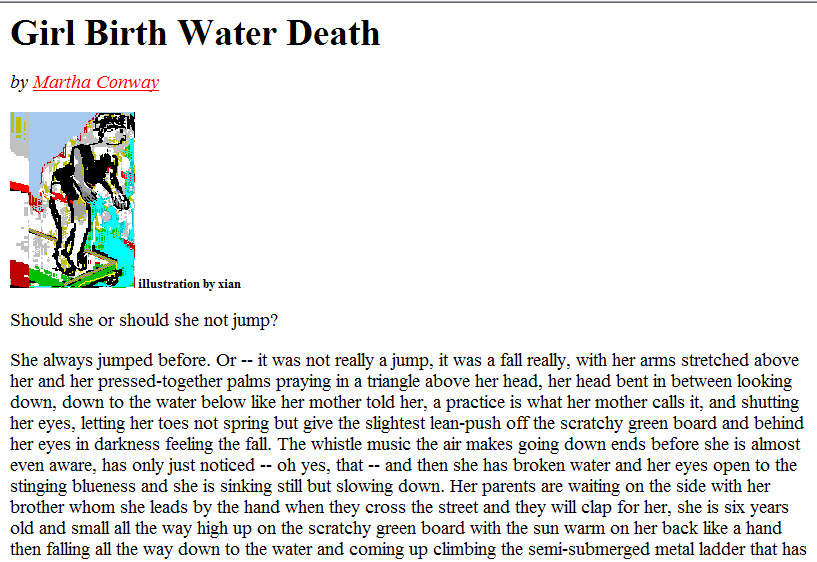
Marjorie Coverley Luesebrink, The Quaker Oat Box – Infinite Regress
|
Well before the postmodernists romanced the
infinite regress, Proust and Gide were working in this vein.
And, in Huxley’s *Point Counter Point* (a text often cited)
Philip Quarles is a novelist writing a book about a novelist - and he
muses about the strategy:
Put a novelist into the novel.
[...] Specimens of his work may illustrate other possible or
impossible ways of telling a story. And if you have him telling parts of
the same story as you are, you can make a variation on the theme. But
why draw the line at one novelist inside your novel? Why not a second
inside his? And a third inside the novel of the second?
[...] At about the tenth
remove you might have a novelist telling your story in algebraic symbols
or in terms of variations in blood pressure, pulse, secretion of
ductless glands, and reaction times.
This
description sounds suspiciously like innovations we might find in
electronic literature – especially the visualization of story in
algebraic symbols (I am thinking of works that use coding such as Talan
Memmot’s *Lexia to Perplexia*, Mez’ *Cross-ova-ing*, and Stephanie
Strickland’s *slippingglimse*.
These can also include works such as my current
piece-in-progress, *Tin Towns*, constructed with Excel sheets, or an
older work, Fibonacci’s Daughter). However, while all of these might have come from
the pen of Huxley’s magical novelist, the formal aspects of Huxley’s
intimations are too extensive to deal with in this context.
Instead, I want to talk about the Visual and Technical aspects
of the sense of Infinite Regress as it relates to nostalgia in E-lit.
Of course all literature – oral, written, and
computer-mediated - ages over time.
Setting aside all issues of old parchment, leather volumes,
antique typefaces – should *Gone With the Wind* (relatively recent,
after all) – be printed on new paper or even delivered to a Kindle, the
diction, imagery, descriptions, and even the plot would tell a tale of
decades gone by. This is a
natural consequence of the evolution cultures and of language, itself.
But there is another kind of aging that we can recognize in
electronic writing.
|

Ana Marie Uribe’s *A Shoal of Mermaids*
In a recent article in
Readability.com entitiled -
Digital Orpheus: The Hypertext Poem in Time
Benjamin
Paloff
speculates that hypertext poems composed in the late 1990s have aged
relative to their counterparts in traditional print.
He asks a central question:
Why then, we may ask, do hypertext poems appear to age on the screen so
much faster than their counterparts in print?
To
which one could easily add – Why does all hypertext literature appear to
age on the screen so much faster than similar counterparts in print?
My
first response to Paloff’s theory was – oh, yes.
I, too, sensed that, somehow, e-lit came with an almost instant
nostalgia – a sense, even within months, which the screen product was
somehow always-already receding into the technological past.
It was if the writer’s paradise was quickly lost in the rush of
change.
In conversations with e-lit practitioners, I
had heard some of the same musings.
And, yet, first, I wondered what the reason might be.
And then I was also curious about the actual evidence.
Paloff’s partial answer for the reason is this – he states:
“What makes the hypertext poem special is not that the computer’s
mediation of the text makes the poem new each time the reader encounters
it, but that it integrates those display choices with the text so
thoroughly that the poem’s age can be seen in the age of the display.”
Hypertext poetry, and by extension, all hypertext literature, he states,
“is inevitably subject to technological obsolescence as regards both its
compositional (language) [[and for this I am reading the vocabulary of
the software]] and distributional media.”
That seemed like a good place to start – a way to
look at the evidence.
We might look at the
Infinite Regress as it applies to Electronic Literature from about 1992
– a nice, twenty-year span – to see if we find the
predicted
nostalgia. |

|
In addition to the comprehensive ELO Directory,
there actually are several vintage sites still in existence that have
links to web works of very early writers.
Carolyn Guertin’s Assemblage and Michael Shumate’s Hyperizons
include works going back to the early 1990’s – and links to the earliest
pieces that are still online (surprisingly, many are, although the url’s
may have changed, you can often find the work by doing a search for the
author or title).
Having expected to find that the “old” web pieces
looked hopelessly antique and clunky, I was surprised to see that, if
the browser was displaying the work at a current-level resolution, many
of these works, while not appearing quite contemporary, had aged well.
Two early works that might illustrate this are Martha Conway’s
*Girl Birth Water Death* from 1995 and Ana Marie Uribe’s series, *A
Shoal of Mermaids*.
|